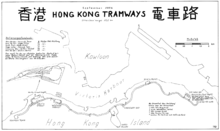
The Mass Transit Railway (MTR) is a major public transport network serving Hong Kong. Operated by the MTR Corporation (MTRCL), it consists of heavy rail, light rail, and feeder bus service centred on a 10-line rapid transit network serving the urbanised areas of Hong Kong Island, Kowloon, and the New Territories. The system included 245.3 km (152.4 mi) of rail as of December 2022 with 179 stations, including 99 heavy rail stations, 68 light rail stops and 1 high-speed rail terminus.

The Kowloon–Canton Railway was a railway network in Hong Kong. It was owned and operated by the Kowloon–Canton Railway Corporation (KCRC) until 2007. Rapid transit services, a light rail system, feeder bus routes within Hong Kong, and intercity passenger and freight train services to China on the KCR network, have been operated by the MTR Corporation since 2007.

The Kowloon-Canton Railway Corporation is a Hong Kong wholly government-owned railway and land asset manager. It was established in 1982 under the Kowloon-Canton Railway Corporation Ordinance for the purposes of operating the Kowloon–Canton Railway (KCR), and to construct and operate other new railways. On 2 December 2007, the MTR Corporation Limited (MTRCL), another railway operator in Hong Kong, took over the operations of the KCR network under a 50-year service concession agreement, which can be extended. Under the service concession, KCRC retains ownership of the KCR network with the MTRCL making annual payments to KCRC for the right to operate the network. The KCRC's activities are governed by the KCRC Ordinance as amended in 2007 by the Rail Merger Ordinance to enable the service concession agreement to be entered into with the MTR Corporation Limited.

The Kwun Tong line is a rapid transit line of the MTR network in Hong Kong, coloured green on the MTR map. Starting at Whampoa in Hung Hom and ending at Tiu Keng Leng in Tseung Kwan O, Sai Kung, the route has 17 stations and takes 35 minutes to complete. The Kwun Tong line is one of the busiest railway lines on the network connecting the central and the eastern portions of Kowloon via Wong Tai Sin. The line is mostly underground, but includes a lengthy elevated section, and runs generally in an east-west direction. During the morning rush hour, the Kwun Tong line utilises 33 trains running at 29tph to achieve a route capacity of 85,000 pphpd.

The West Rail line was a rapid transit line that formed part of the Mass Transit Railway (MTR) system in Hong Kong until 27 June 2021. Coloured magenta on the MTR map, the line ran from Tuen Mun to Hung Hom, with a total length of 35.7 kilometres (22.2 mi), in 37 minutes. The railway connected the urban area of Kowloon and the new towns of Yuen Long, Tin Shui Wai and Tuen Mun in the northwestern New Territories.
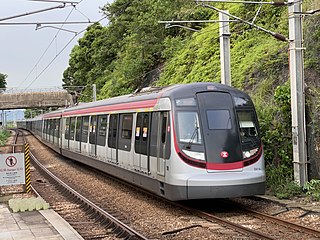
The East Rail line is one of the ten lines that form MTR, the mass transit system in Hong Kong. The railway line starts at Lo Wu or Lok Ma Chau, both of which are boundary crossing points into Shenzhen and joins in the north at Sheung Shui and ends at Admiralty station on Hong Kong Island. At approximately 46 km (29 mi), the line is the second longest line within the network, behind the Tuen Ma line. The line's colour is light blue.

MTR Corporation Limited is a majority government-owned public transport operator and property developer in Hong Kong which operates the Mass Transit Railway, the most popular public transport network in Hong Kong. It is listed on the Hong Kong Exchange and is a component of the Hang Seng Index. The MTR additionally invests in railways across different parts of the world, including franchised contracts to operate rapid transit systems in London, Stockholm, Beijing, Hangzhou, Taipa, Shenzhen, Sydney, and a suburban rail system in Melbourne.

Hung Hom is a passenger railway station in Hung Hom, Kowloon, Hong Kong. It is an interchange station between the East Rail line and the Tuen Ma line domestic services of the MTR network, as well as the southern terminus of cross-border through-trains to mainland China which has been suspended since 4 February 2020. The station is one of four Hong Kong ports of entry on the MTR network; the others are Lo Wu, Lok Ma Chau, and West Kowloon. This station serves the southern terminus of the East Rail Line in early morning before the first northbound train from Admiralty arrives. As the station is located next to the Cross-Harbour Tunnel's northern portal, it is also served by many cross-harbour bus routes.
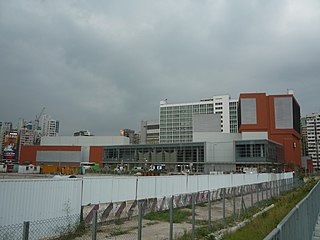
The Kowloon Southern link is a section of the MTR East Rail and Tuen Ma line linking Nam Cheong station and Hung Hom station. The rail link is fully underground, lies along the south-west coastline of Kowloon Peninsula, east of rail tracks of the Tung Chung line and Airport Express. Kowloon Southern Link has one underground intermediate station called Austin station. It is located adjacent to the Canton Road Government Offices, close to Kowloon station of Tung Chung line and Airport Express. However, the structures do not provide a direct transfer between the two stations.

MTR Bus is a public non-franchised bus service in Hong Kong operated by the MTR Corporation, serving the northwestern part of the New Territories. It comprises a network of 22 feeder bus routes for the convenience of passengers using the MTR rapid transit network, providing access to and between many MTR stations on the Tuen Ma line and Light Rail.
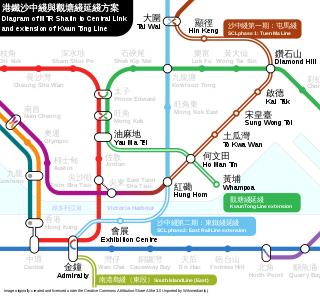
The Sha Tin to Central Link was an expansion project of the MTR public transport network in Hong Kong. It was divided into two sections and expanded the network’s heavy rail lines.

The SP1900 EMU / SP1950 EMU or IKK Train is a model of train that runs on Hong Kong's Tuen Ma line. It was the second model of electric multiple unit rolling stock of the Kowloon-Canton Railway Corporation (KCRC), though they have been operated by MTR Corporation (MTRC) after it merged with KCRC in 2007.

The Guangzhou–Kowloon through train was an inter-city railway service between Hong Kong and Guangzhou jointly operated by the MTR Corporation of Hong Kong and the Guangzhou Railway Group of mainland China. Services operate along the East Rail line within Hong Kong territory, crossing the Hong Kong–Chinese border at Lo Wu, and continuing along the Guangmao Railway and Guangshen Railway in Guangdong province.
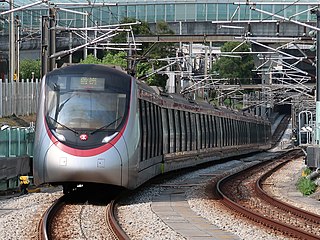
The Tuen Ma line is a rapid transit line that forms part of the Mass Transit Railway (MTR) system in Hong Kong. Coloured brown on the map, the Tuen Ma line is 56.2 kilometres (34.9 mi) in length, making it the longest line of the MTR network. It has a total of 27 stations, more than any other in the MTR system.

The Hong Kong section of the Guangzhou–Shenzhen–Hong Kong Express Rail Link is a 26 km (16 mi) long stretch of high-speed rail that runs along a dedicated underground rail corridor linking Hong Kong to mainland China. It is one of the most expensive infrastructure undertakings in Hong Kong's history. The line connects Kowloon with the high-speed rail network of China at Futian station in the technology hub of Shenzhen, then running north towards the commercial/ political hub of Guangzhou. As of August 2023 the line has an average ridership of 79,000 passengers a day.
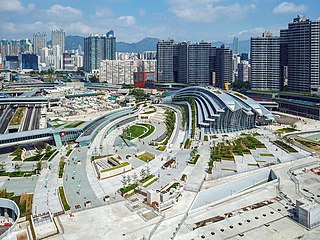
West Kowloon station, also known as Hong Kong West Kowloon, is the southern terminus of and the only station on the Hong Kong section of the Guangshengang XRL. The station connects to China's high-speed rail (HSR) network across the border through dedicated tunnels and includes a Mainland Port Area where the laws of (Mainland) China are enforced. It was constructed by the MTR Corporation Limited as the project manager commissioned by the Hong Kong Government, through subcontractors.
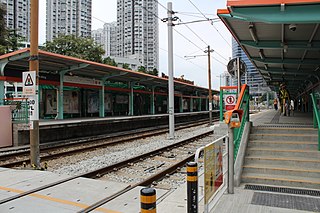
Tin Wing is an MTR Light Rail stop. It is located at ground level beside Tin Shing Road in Tin Shui Wai Town Centre, Yuen Long District. It began service on 26 March 1995 and belongs to Zone 4.

Guangzhou–Shenzhen–Hong Kong Express Rail Link (XRL), also known as the Guangshengang XRL, is a high-speed railway line that connects Beijing and Hong Kong (Kowloon) via Guangzhou and Shenzhen.

Vibrant Express, also known as MTR CRH380A or MTR380A is a high-speed train operated by Hong Kong government-owned public transport operator MTR. It was manufactured by Chinese state-owned manufacturer CSR Qingdao Sifang based on the CRH380A Hexie EMUs developed for China Railway. Nine 8-car trainsets were ordered by the Hong Kong government through the MTR Corporation and delivered between 2016-17. It is the first high-speed train produced by CRRC not operated by China Railway.

